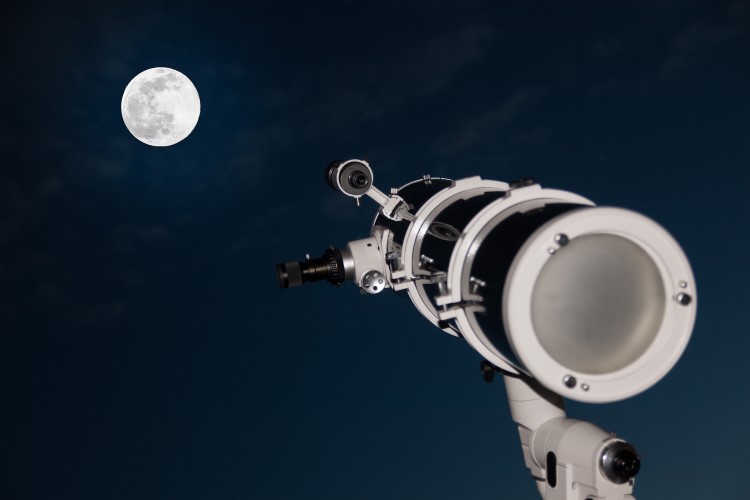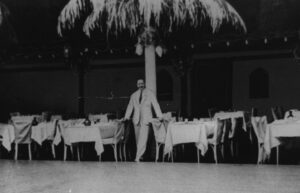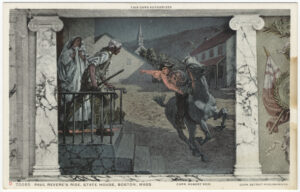
Slide Rules, A Big Bang, and the Moon
Dateline: 1958 – Cold War America. The United States failed twice to launch a man-made satellite into orbit. In late 1957, the Soviets successfully launched a beach ball sized satellite under its Sputnik space program. Americans feared that the Soviets remained perched on the cusp of winning the Space Race, and with it, nuclear supremacy. This “Sputnik Crisis” sent the already overheated space exploration community into hyper-drive. No costs would be sparred to achieve space supremacy.
The U.S. needed something grand to recapture the faith of the American people, justify the flow of endless dollars to the space program, and show up the Soviets. Top Secret Air Force Project A119 was just the ticket. In 1958, the U.S. created Project A119 – A Study of Lunar Research Flights.
Detonating a nuclear bomb on the surface of the Moon remained the stated goal of Project A119. Blowing up the Moon with a nuke would assist in studying mysteries in planetary astronomy and astrogeology. In addition, the flash from a nuclear explosion on the Moon should be visible from earth, including being visible to the Soviets. Ahh. There it is. The true mandate for Project A119: a show of military force and boost to domestic morale to respond to the Sputnik Crisis.
Officially, Project A119 remains a Top Secret, classified project. The U.S. Government will not acknowledge its existence or respond to formal requests for information. Enter a youthful Carl Sagan. In 1958, Carl Sagan continued his doctoral studies at the Illinois Institute of Technology, including the development of mathematical projections of the expansion of a dust cloud resulting from detonating a nuclear bomb on the lunar surface as part of Project A119.
In 1959, Sagan applied for an academic scholarship at the University of California, Berkeley. In the application, Sagan provided extensive details of his involvement with Project A119, including identifying two papers to which Sagan contributed: Possible Contribution of Lunar Nuclear Weapons Detonations to the Solution of Some Problems in Planetary Astronomy, and Radiological Contamination of the Moon by Nuclear Weapons Detonations. Apparently, Carl Sagan missed all the memoranda and instructions about the Top Secret nature of Project A119. These disclosures were still maintained under wrap until a 1999 biography of Sagan disclosed them to the public at large.
After publication of this 1999 biography, the leader of Project A119, Leonard Reiffel, acknowledged that a ten-member team evaluated blowing up the Moon. The team studied utilizing different types of atomic bombs; effects of an atomic explosion in oxygen-free space; Earthly visual impacts of a nuclear detonation on the dark side of the Moon; and magnitude of resultant dust clouds. In offering these revelations in 2000, Reiffel, a retired NASA top executive, denunciated all the work for Project A119, noting that as a scientist, he was “horrified that such a gesture to sway public opinion was even considered.” Better late than never with remorse.
Yet, in 1958, apparently neither Reiffel nor Sagan (or any of the ten-member scientific team) were sufficiently “horrified” with Project A119. Indeed, they proceeded studying the atomic, scientific, engineering and mathematical angles of blowing up a nuclear device on the Moon. In 1958 America, we were not far removed from Senator Joseph McCarthy’s Communist witch hunts. The father of the atomic bomb, Robert Oppenheimer, became person non-grata after publicly opposing development of a thermonuclear bomb. The Project A119 scientists lived through the atrocities of WWII, with some of them fleeing to the United States. The Cold War represented part of the fabric of everyday life. Failure to embrace and support a patriotic cause of the U.S. would get you labeled a Communist, or at least a sympathizer. These real-life dynamics do not justify Project A119, but they do help to explain how the scientific community actively participated in such an exercise.
Today, the mere idea of blowing up the Moon does not merely sound incredibly stupid, but also insane. In 1958, perhaps the full effects of nuclear explosions were not truly appreciated or understood. Nonetheless, the Government, scientists, and general public certainly knew that atomic weapons presented significant, and lasting, impacts. To illustrate both the known dangers and limits of our knowledge at that time, simply look to the nuclear bomb drills in schools with students taking cover under their desks for protection from nuclear bombs. Radiation could not possibly permeate those protective Math and Spelling books in the desks above the students’ heads! In fairness, if nuclear fallout had to stop to diagram a sentence, it may have been stunted in its progress.
Even with consideration of societal pressures and dynamics in the late 1950s, the U.S. charged some of the very top scientists to devise a plan to blow up the Moon. Just who made the decision and how did it unfold? With Top Secret status still invoked by the U.S. 65 years later and generally limited available information, we can only speculate as to the origins of the plan to nuke the Moon. Two groups appear as prime candidates to start us along this nuclear path: the Military/Political faction and the Scientific community. I envision that each group approached the decision in different fashions.
The Scientific Committee brought together by the Air Force would have consisted of top scientists, engineers and mathematicians. The foundation meeting might have progressed as follows:
“Okay, Gentlemen [Side Note: All Committee members are male as the professional deck was entirely stacked against women in 1958 and beyond], the Soviets successfully launched a satellite and our two efforts failed. America relies on us to come up with an amazing and better plan. Any ideas?”
“Well, Boss, hear me out on this one. I have out of the box thinking here. We have trouble with satellites, but we are pretty good with nuclear bombs. We can by-pass the entire circling the Earth phase and proceed directly to delivering a nuclear bomb to the Moon. We can detonate it on the Moon’s surface so that the Soviets can see the mushroom cloud. Now, that will be impressive.”
“That is big thinking, indeed. But what about environmental impacts, radiation, or safety issues in transporting a nuclear bomb by rocket?”
“We’ll call the Project The Study of Lunar Research Flights so it sounds like we are actually studying those kind of issues. The rest are details, details, details. We have the brightest minds from all scientific fields in this room. What could possibly go wrong? To the Moon, I say, and let’s blow it up!”
All Committee members cheer: “To the Moon! To the Moon! Give that guy another pocket protector and slide rule!”
Perhaps a little out of character for scientists, but we do know that some group came up with the idea for Project A119. Let’s check in with the hypothetical initial meeting of the Military and Political leaders.
“Okay, Boys [Side Note: Not even consideration of women in this group in 1958], the Soviets successfully launched a satellite and our two efforts failed. America relies on us to come up with an amazing and better plan. Any ideas?”
“Well, General, hear me out on this one. I have an idea to knock the red socks off the Ruskies. Well strap a nuclear bomb to a rocket, send it to the Moon, and blow out a new crater so the Man in the Moon has a dimple in his chin. The Soviets will pee their pants in fear and every American will love us.”
“Brilliant! Promote that guy two ranks!
“Excuse me, General, but what about environmental impacts, radiation, or safety issues in transporting a nuclear bomb by rocket?”
“Who invited the Commie sympathizer? Those are details, details, details. Those eggheads in the other room will love the challenge to make this happen within twelve months. For political cover, we will call the Project The Study of Lunar Research Flights. What could possibly go wrong?”
All Military and Political Committee members chant: “Blow up the Moon! Blow up the Moon!” Meeting adjourned.
These imaginary initial meetings are fantastic, and yet, the U.S. Government became determined to proceed with Project A119 with a goal to detonate a nuclear bomb on the surface of the Moon just to show up the Soviets. Some group actually analyzed these issues in some detailed fashion and decided to proceed with a full Top Secret Project. Our leaders at work.
Not to be outdone, years later we learned that at the same time, the Soviets embarked on their own Top Secret Project E-4. Project E-4 included a plan to deliver and detonate an atomic bomb on the Moon’s surface. This revelation does not make Air Force Project A119 less insane. Instead, the existence of a parallel Soviet plan to blow up the Moon simply confirms that many passengers can fit in the Crazy Boat at the same time.
The Soviets successfully launched the Sputnik satellite in 1957 and the Cold War turned into a Space Race on steroids. Both the U.S. and Soviets set their sights on the Moon. Exploration of the nearest orbiting body? Nope. Scientific examination of the makeup of the Moon and what it might teach us? Nah. Study the effects of no gravity? Not even close. Rather, Mankind’s first interaction with a planetary object beyond the Earth would be a nuclear kiss of death. “One small nuclear device detonated on the Moon’s surface. One enormous mushroom cloud to scare our enemies.” Not quite as catchy as Neil Armstrong.
Fortunately for the human race, the U.S. eventually abandoned Project A119 determining that the risks of an explosion during the launch cycle outweighed potential benefits. Please note, the potential impacts on the Moon were not among the reasons to abandon the project. Independently, the Soviets also scrapped Project E-4 for unstated “safety concerns.” In reality, both the U.S. and Soviets recognized that any dust cloud or mushroom cloud associated with a lunar nuclear explosion would fail to produce the desired, dramatic, visible with the naked eye, impact so coveted. As the explosion would be a dud from the perspective of the Earth, why bother? The Moon was saved as it was simply too far away for target practice.
In the 1960s, the U.S. and Soviet Union entered two treaties in which the Superpowers pledged to keep the Moon out of consideration for any nuclear testing or targeting. By that time, both countries knew that a lunar nuclear strike would have little showmanship effect. Whatever the reasons, these treaties rendered moot the need for another Project A119. Let’s hope that there is not a different Project A120 under consideration (or actually in play).
In estate planning meetings with clients, we inevitably reach the “what if” phase in discussing alternate trustees or agents to serve in plan documents and address contingent circumstances. At times, clients may roll their eyes and I know they are thinking that the exercise is silly as certainly those events I describe could never come to fruition. Even with the most far fetching hypotheticals I present, I have never invoked an example of detonating an inter-planetary nuclear device as a concern.
Nonetheless, when clients question the likelihood of crazy hypothetical events I conjure, I may now remind them that our Government spent years funding a project to blow up the Moon. Unlikely and unexpected events abound in our lives. We need to plan — perhaps not using our Living Trusts and Wills to address interplanetary nuclear excursions — but instead to account for the unlikely challenges which may arise in our families and business affairs. In the meantime, enjoy the Moon while we still have it.




